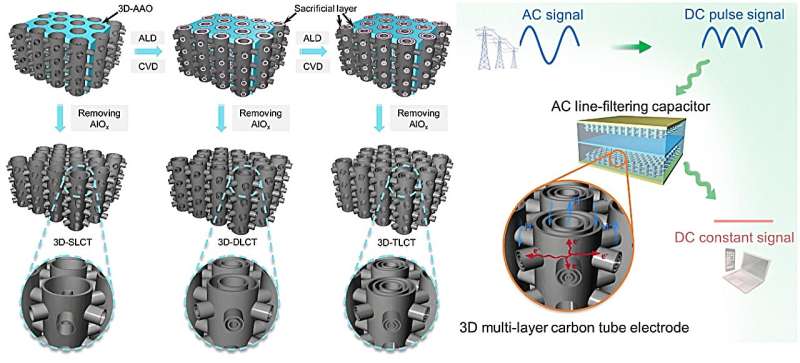This article has been reviewed according to Science X's editorial process and policies. Editors have highlighted the following attributes while ensuring the content's credibility:
fact-checked
trusted source
proofread
'Matryoshka doll' structures provide solution for next-generation miniaturized filter capacitors

A research team led by Prof. Meng Guowen and Prof. Han Fangming from the Hefei Institutes of Physical Science of the Chinese Academy of Sciences, together with Prof. Wei Bingqing from the University of Delaware, miniaturized line-filtering capacitors with "matryoshka doll" structure electrodes, providing a high-performance and space-saving solution for line-filtering applications.
Their study is published in Joule.
Filter capacitors are critical components in the conversion of alternating current (AC) to direct current (DC) to power electronic devices. Current market leaders, such as aluminum electrolytic capacitors (AECs), are bulky and limit miniaturization efforts. Electric double-layer capacitors (EDLCs) with higher specific capacitance show promise, but their traditional curved and complex pore structures hinder line-filtering applications due to poor frequency response.
In this study, the researchers presented a novel design to solve this problem. They used a three-dimensional interconnected porous anodized aluminum oxide (3D-AAO) template. Through meticulous deposition processes, they created a 3D framework of double- or triple-layered carbon tubes with a coaxial structure similar to the nested layers of matryoshka dolls. This configuration maximizes the surface area for charge storage and promotes rapid electrolyte ion transport.
Assembling symmetrical EDLCs with these "matryoshka doll" 3D multi-layer carbon tube (MLCT) electrodes yielded impressive results. The devices exhibited exceptional impedance phase angles and low resistance-capacitance time constants, indicating efficient ion transport. The specific areal capacitance exceeded that of commercial AECs by two orders of magnitude, with minimal power dissipation and remarkable energy storage efficiency.
Further testing confirmed the excellent frequency response and filtering capabilities of the series-connected device bank, which effectively converts various input signals into stable DC outputs. A practical demonstration of the device's ability to filter pulse voltages and illuminate a light-emitting diode underscores its potential for high-performance miniaturized filter capacitors.
"This matryoshka doll structure of 3D MLCT electrodes for supercapacitors shows high specific capacitance and exceptional frequency response performance," said Prof. Meng. "It provides a breakthrough approach for the design of next-generation high-performance miniaturized filter capacitors."
More information: Gan Chen et al, Three-dimensional multi-layer carbon tube electrodes for AC line-filtering capacitors, Joule (2024). DOI: 10.1016/j.joule.2024.01.026

















